Japanese Festivals – Must-See Cultural Events Throughout the Year
Japan is a country where tradition and modernity coexist harmoniously, and nowhere is this more evident than in its vibrant Japanese festivals. These festivals, known as “matsuri,” offer an immersive experience into the rich culture, history, and community spirit of Japan. Celebrated throughout the year, Japanese festivals showcase colorful parades, traditional music, elaborate costumes, and centuries-old rituals, drawing locals and tourists alike.
Whether you’re planning your trip to coincide with one of these cultural spectacles or simply wish to learn about the most iconic Japanese festivals, this guide covers the must-see events and provides practical tips for a memorable experience.
Why Japanese Festivals Are Unmissable
Japanese festivals are a unique expression of Japan’s cultural identity. They provide insight into the nation’s spiritual beliefs, agricultural heritage, historical milestones, and regional diversity. Each festival has its own story, atmosphere, and significance, making them far more than just entertainment—they are a living tradition.
1. Gion Matsuri (Kyoto – July)
One of the most famous Japanese festivals, Gion Matsuri dates back to 869 AD. Held throughout July, it centers around the grand Yamaboko Junko parade.
Highlights:
-
Yamaboko Floats: Lavishly decorated floats representing various districts of Kyoto.
-
Street Stalls: Local food, traditional crafts, and festival games line the streets.
-
Cultural Experience: Participate in traditional music, processions, and ceremonies.
Insider Tip:
Book accommodations well in advance as Kyoto gets extremely crowded during this festival.
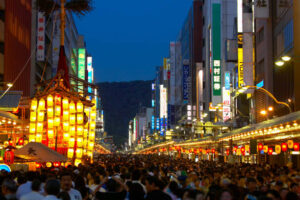
2. Nebuta Matsuri (Aomori – August)
Nebuta Matsuri is a vibrant and energetic Japanese festival held in Aomori Prefecture, famous for its illuminated floats.
Highlights:
-
Giant Lantern Floats: Intricately designed floats depicting mythical warriors and historical figures.
-
Traditional Music: Accompanied by lively taiko drums and flutes.
-
Participants in Costumes: Dancers and musicians in traditional attire enliven the streets.
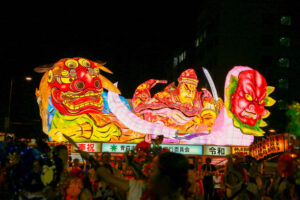
3. Sapporo Snow Festival (Hokkaido – February)
The Sapporo Snow Festival is one of the most spectacular Japanese festivals held in winter, attracting millions of visitors.
Highlights:
-
Snow Sculptures: Massive, detailed snow and ice sculptures.
-
Illuminated Displays: Nighttime displays enhance the magical atmosphere.
-
Local Food Stalls: Sample Hokkaido’s winter specialties like seafood and hot ramen.
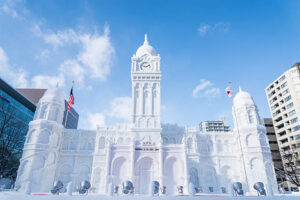
4. Awa Odori (Tokushima – August)
Awa Odori is one of the most traditional Japanese festivals, known for its joyful dancing and folk music.
Highlights:
-
Dance Processions: Groups of dancers perform traditional Awa dances through the streets.
-
Traditional Instruments: Accompanied by shamisen, drums, and flutes.
-
Participation: Visitors can join in and dance along.
Insider Tip:
Best experienced in the evening when the atmosphere becomes electric with lights and music.
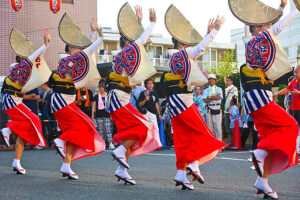
5. Tanabata Festival (July – Across Japan)
Tanabata, also called the Star Festival, celebrates a legendary story about star-crossed lovers.
Highlights:
-
Colorful Decorations: Bamboo branches adorned with colorful paper strips containing wishes.
-
Cultural Storytelling: Tales of Orihime and Hikoboshi are told through local events.
-
Local Variations: Each region celebrates with its unique style.
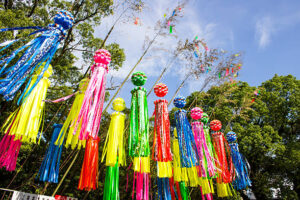
6. Kanda Matsuri (Tokyo – May, Odd Years)
Kanda Matsuri is one of Tokyo’s largest and most historic Japanese festivals, held every two years.
Highlights:
-
Mikoshi Processions: Portable shrines carried through the streets.
-
Traditional Performances: Music and dance from Tokyo’s cultural past.
-
Historical Significance: Dates back to the Edo period, originally held to pray for prosperity.
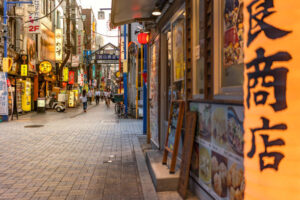
7. Takayama Matsuri (Gifu – April & October)
Takayama Matsuri is renowned for its beauty and is among the top Japanese festivals for traditional floats.
Highlights:
-
Yatai Floats: Elaborate wooden floats adorned with carvings and mechanical puppets.
-
Seasonal Versions: Spring festival celebrates the planting season; Autumn festival celebrates the harvest.
-
Historic Town Setting: Takes place in Takayama’s charming old town.
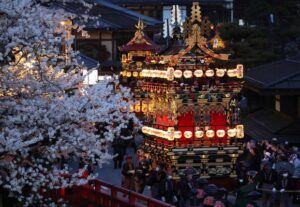
8. Hakata Gion Yamakasa (Fukuoka – July)
This exhilarating Japanese festival is famous for its speed and competitive spirit.
Highlights:
-
Yamakasa Floats: Teams race carrying large floats through narrow streets.
-
Energetic Atmosphere: The event is highly competitive and full of excitement.
-
Cultural Rituals: Strong ties to local Shinto beliefs.
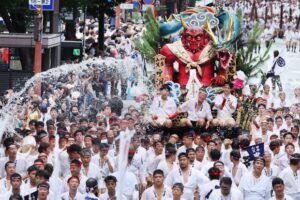
9. Obon Festival (Mid-August)
Obon is one of the most spiritually significant Japanese festivals, dedicated to honoring ancestors.
Highlights:
-
Lantern Floating: Small lanterns are floated down rivers to guide spirits back to the afterlife.
-
Bon Odori Dance: Traditional dances performed in local communities.
-
Family Gatherings: People return to ancestral homes.
Travel Tip:
Book accommodations in advance, as it’s a popular holiday period in Japan.
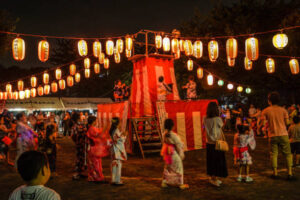
10. Jidai Matsuri (Kyoto – October)
Jidai Matsuri, or the Festival of the Ages, is a historic Japanese festival celebrating Kyoto’s imperial past.
Highlights:
-
Historical Parade: Participants dressed in period costumes from Japan’s history.
-
Cultural Insight: Offers a timeline of Japanese fashion and culture.
-
Kyoto Imperial Palace: The festival begins here, making it a cultural highlight.
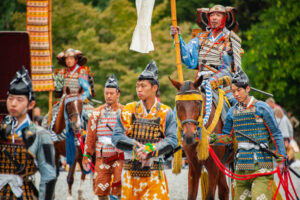
11. Yuki Matsuri (Snow Festivals in Smaller Towns)
Beyond Sapporo, many smaller towns in Japan hold charming local snow festivals, adding to the list of Japanese festivals.
Highlights:
-
Local Sculptures: Smaller but equally intricate snow sculptures.
-
Community Atmosphere: Less crowded and more intimate.
-
Traditional Performances: Local folk music and dance.
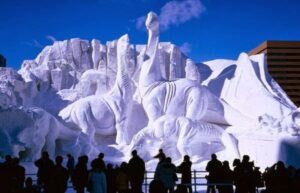
12. Festivals Unique to Each Region
Many Japanese festivals vary by region, showcasing local culture and traditions.
Examples:
-
Kishiwada Danjiri Matsuri (Osaka): High-speed float-pulling race.
-
Shirakawa-go Doburoku Festival (Gifu): Celebrating homemade sake.
-
Niigata Fireworks Festival: Stunning summer night fireworks display over the river.
Practical Travel Tips for Experiencing Japanese Festivals
-
Plan Ahead: Many festivals attract huge crowds. Booking hotels and transportation early is essential.
-
Respect Local Customs: Always follow the rules, especially in sacred or historical settings.
-
Festival Calendar: Check local tourism websites for exact dates, as some festivals follow the lunar calendar or change yearly.
-
Cash is King: Many food stalls and games don’t accept cards.
-
Dress Comfortably: Wear traditional yukata if possible for a more immersive experience.
Sample Festival Itinerary in Japan
Day 1: Tokyo
-
Visit Kanda Matsuri (if in May).
-
Explore Asakusa for local crafts and street food.
Day 2: Kyoto
-
Gion Matsuri highlights, including Yamaboko floats.
-
Evening stroll through historic Gion district.
Day 3: Aomori
-
Experience Nebuta Matsuri with its illuminated floats.
Day 4: Hokkaido
-
Visit the Sapporo Snow Festival in February or a local winter festival.
Conclusion – Experience the Heart of Japan Through Festivals
Japanese festivals are a vibrant, living tradition that captures the spirit and history of Japan. Whether it’s the explosive energy of Awa Odori, the serene lantern floats of Obon, or the intricate artistry of Takayama’s floats, each festival provides a unique window into Japanese culture. Every traveler visiting Japan should plan their trip around these celebrations to experience an unforgettable and immersive cultural adventure.
Start exploring the most iconic and lesser-known Japanese festivals to enrich your journey with color, rhythm, history, and joy.
Follow Us: Instagram